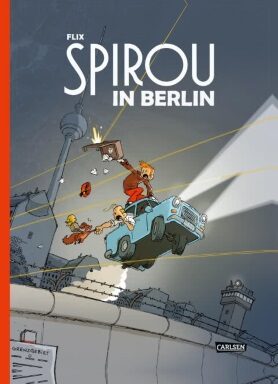Flix Flix
Spirou in Berlin
[Spirou in Berlin]
- Carlsen Verlag
- Hamburg 2018
- ISBN 978-3-551-72115-0
- 64 Pages
- 9 Suitable for age 10 and above
- Publisher’s contact details
Sample translations
A comic-strip hero gets involved in Germany’s recent history
As the first German comic artist, Flix is the newest member of the illustrious circle of illustrator/authors of the traditional Franco-Belgian comic series. And rightly so. With a turbulent story inspired by events that had taken place shortly before the fall of the Berlin Wall in November 1989.
At first glance, one is struck by the witty, satirical and joyful experimentation of the Ligne Claire drawing style that the artist employs to create a distinctive atmosphere. In thrillingly synchronized changes of perspective, the images create scene for scene an action packed plot that could keep pace with a James Bond film.
In the summer of 1989, Graf von Rummelsdorf receives an unexpected invitation to the First International Congress of Mycologists in East Berlin, the capital of the GDR. Since Spirou’s and Fantasio's friend is naturally also a renowned mushroom researcher, he accepts – full of hope that he will learn something about the “small-headed Portabriris”, an extremely rare mushroom that possesses extraordinary properties: its spores don't merely deform metal, its serum can even - as we discover in the course of the story- set in motion an ominous “wonder weapon of socialism”.
The professor disappears as he heads towards East Berlin under mysterious circumstances. Spirou, Fantasio and Pips follow his lead and get suspicious. They set off for East Berlin by way of West Berlin and are surprised at how peaceful and colorful life goes on in the workers' and farmworkers' country. Little do they suspect, however, that that they have been targeted by the state security right from the very start. The situations they get themselves into, depicted in the style of a nerve-racking spy thriller along with a good measure of slapstick elements, would make any self-respecting historian’s hair stand on end: mind-boggling chase scenes, shoot-outs, arrests, interrogations, stopovers in a luxury hotel, in a prison cell, and in an underground military experiment laboratory, then they are rescued by a herd of orangutans and finally they make the acquaintance of a young woman who had been bitterly disappointed by real socialism and is determined to do anything and everything. But not to worry: the historian’s hair will soon calm down again.
In the always exceedingly adventurous comic-strip plot of the Spirou stories, Flix peppers in tidbits of verifiable information about contemporary history and everyday life during the final phase of the GDR. The artist, who lives in Berlin, proves to be an expert on events that took place during the time of the peaceful revolution in 1989. Above all, he knows about the differences between the outward appearance of the “peaceful state” and the often subtle, often clumsy repressive mechanisms of the government body vis-à-vis dissenters. This begins with being harassed at border controls and ends in the psycho-terror of the state security against anti-state and suspicious “elements”.
Flix’s Ligne Claire style also makes of him a precise documentarist of the situation on the ground- whether in his depiction of the border crossing at Bahnhof Friedrichstraße (known in the vernacular as the “Palace of Tears”), the facades and interiors of the now demolished East Berlin Palace Hotel, or the street scenes around Alexanderplatz. Even the revolving restaurant in the television tower is used as a setting for dramatic events.
That the characters move as caricature types in front of this realistic backdrop and credibly drawn milieus, and drive the action to mindboggling extremes, also facilitates the reader's process of cognition. Small Aha experiences combine with great reading pleasure. Irony and satirical exaggeration have always been extremely useful tools and feared by those in power, for their ability to expose individual and social conditions worthy of criticism. In this regard, young readers in particular who want to learn and read about the history of the German-German division in a less conventional way will hunger for more such topics in the form of exciting, imaginative and yet profound comics!
The whole album is available here: http://www.europecomics.com/album/spirou-in-berlin/
Translated by Zaia Alexander

By Siggi Seuß
Siggi Seuß, freelance journalist, radio script writer and translator, has been writing reviews of books for children and young people for many years.
Publisher's Summary
A German graphic artist commissioned to draw a French-Belgian comic classic like Spirou & Fantasio is no small sensation.
The popular graphic artist Flix transposes the characters to East Berlin in the 1980s, where they search for Count Rummelsdorf who has disappeared. Along the way they uncover a number of extremely bizarre things: people kidnap bathtubs in East Berlin and the heroes meet up with an old acquaintance...
Action-packed, fast-paced and with lots of flair, Flix tells a German adventure of Spirou and Fantasio.
(Text: Carlsen Verlag)
